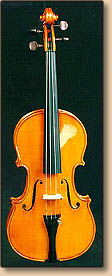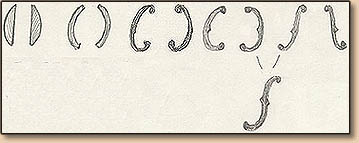The complete violin family was born round about the same time. The viola
is sometimes considered the prototype. In 1535 appeared descriptions of
both the viola and the cello. The violin rapidly replaced both the rebec
and the lyre, but the viola da gamba instruments were common for almost
another couple of centuries. Time eventually overtook the gamba, when
polyphonic music, suitable for the gamba, was replaced by new musical
fashions.
It is not possible to say precisely when the first violin was created, but
apparently the form was evident around the turn of the fifteenth and
sixteenth centuries. No individual can be named as the originator of the
violin. It is known only that the violin originated in Italy, and from
there it spread throughout Europe. The inventor-genius Leonardo da Vinci
(1452-1519) made sketches of the modern violin.
One of the first known violinmakers was Andrea Amati (circa 1452-1519 :
dates given for his birth and death vary). He was the master and founder
of the Cremona School. Amati was famed as far as the French court, and his
instruments were brought to the court of Kaarle XI, during the
1560's and 70's. The tradition of Amati was continued by the Amati family
of skilled makers, who developed and improved the skill of violin-making
still further. The most renowned of them were Andrea's sons Antonio (b.
1540) and Hieronymous Girolomo (1561-1630). It was due to Girolomo's son
Nicolas, that the Cremona School became the main style of violin-making.
The most famous of all violin makers, Antonio Stradivarius
(1644-1737) is thought to have obtained his training in the Amati workshop. Stradivarius'
early instruments have some of the features of Amati violins. Later
Stradivarius developed his own model, and in his instruments of the
eighteenth century "golden age", he achieved the peak of his skill in
violin making.
Stradivarius' sons Francesco (1671-1743) and Ombono (1679-1742) continued
their father's tradition, but never achieved the same level or fame as
their father.
The Guarneri family, beginning with Andrea Guarneri (1626-1698), was to
continue the Amati tradition. Of the family's five members, perhaps the
most famous was Giuseppe (1698-1744), whose epithet was "del Gesu". In all
probability Jacob Stainer (1621-1683), the founder of the German School,
was also one of the apprentices in the Amati workshop. Gasparo da Salo
(1542-1609) was, after Amati himself, one of the first famous early violin
makers. He founded the Brescia School and Giovanni Paolo Maggini
(1580-1630) was one of the makers to continue this tradition.
Violin making reached its zenith in Italy under the hands of masters of
many Schools. The construction of the violin developed. The fingerboard
was extended in length, because compositions were beginning to demand the
use of the seventh and even higher positions. The shape of the bridge was
altered, and the dampening effect of the mute was invented in 1636. The
violin achieved its final form at the beginning of the nineteenth century.
The neck also became longer, the angle of the neck in relation to the body
was made more acute, and the bridge took on a more curved and higher form.
With the changeover to metal strings, the tension forces on the violin body
grew, which in turn demanded a stronger base bar and soundpost. In 1820 a
chinrest, which supported the playing position, was added to the violin by
L. Spor. Through these changes, the violin gained in dynamics and carrying
power over the old baroque violin. Violins made before 1800 were adapted
to incorporate these changes, so that the violins of the old masters were
no longer in their original state.
There are differences between the Amati or Stainer violins, and the
Stradivarius or Guarneri violins. In the former, the back, and to a
greater extent the belly, are more concave. In contrast, the forms of
Stradivarius and Guarneri violins are flatter and thus better withstand the
increased tension forces imposed by the new developments. Their sound is
also stronger.
At the end of the nineteenth century, violins were hand crafted. During
this century makers began to specialize in particular instruments, whereas
previously they had made other instruments too, such as gambas and lutes.
Factory production reached its peak at the turn of the century,
particularly in Germany and France. Violins were made on a production line
by specialized part makers and assemblers. Despite this development, the
handmade violin still has no rival, having continued the tradition and its
values through the centuries.

|

Viola
Made by Jussi Laasanen, 1998
(copy of Stradivarius)
|


